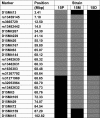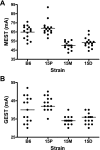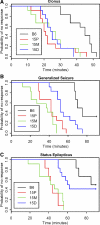Confirmation of multiple seizure susceptibility QTLs on chromosome 15 in C57BL/6J and DBA/2J inbred mice
- PMID: 20571108
- PMCID: PMC2957772
- DOI: 10.1152/physiolgenomics.00096.2010
Confirmation of multiple seizure susceptibility QTLs on chromosome 15 in C57BL/6J and DBA/2J inbred mice
Abstract
To confirm seizure susceptibility (SZS) quantitative trait loci (QTLs) on chromosome (chr) 15 identified previously using C57BL/6J (B6) and DBA/2J (D2) mice and to refine their genomic map position, we studied a set of three congenic strains in which overlapping segments of chr 15 from D2 were transferred onto the B6 background. We measured thresholds for generalized electroshock seizure (GEST) and maximal electroshock seizure (MEST) in congenic strains and B6-like littermates and also tested their responses to kainic acid (KA) and pentylenetetrazol (PTZ). Results document that MEST is significantly lower in strains 15M and 15D, which harbor medial and distal (telomeric) segments of chr 15 (respectively) from D2, compared with strain 15P, which harbors the proximal (acromeric) segment of chr 15 from D2, and with control littermates. Congenic strains 15P and 15M exhibited greater KA SZS compared with strain 15D and B6-like controls. All congenic strains were similar to controls with regard to PTZ SZS. Taken together, results suggest there are multiple SZS QTLs on chr 15 and that two QTLs harbor gene variants that affect MEST and KA SZS independently. The MEST QTL is refined to a 19 Mb region flanked by rs13482630 and D15Mit159. This interval contains 350 genes, 183 of which reside in areas where the polymorphism rate between B6 and D2 is high. The KA QTL interval spans a 65 Mb region flanked by markers D15Mit13 and rs31271969. It harbors 83 genes in highly polymorphic areas, 310 genes in all. Complete dissection of these loci will lead to identification of genetic variants that influence SZS in mice and provide a better understanding of seizure biology.
Figures





Similar articles
-
Quantitative trait locus for seizure susceptibility on mouse chromosome 5 confirmed with reciprocal congenic strains.Physiol Genomics. 2007 Nov 14;31(3):458-62. doi: 10.1152/physiolgenomics.00123.2007. Epub 2007 Aug 14. Physiol Genomics. 2007. PMID: 17698926
-
Fine mapping of a major QTL influencing morphine preference in C57BL/6 and DBA/2 mice using congenic strains.Neuropsychopharmacology. 2008 Nov;33(12):2801-9. doi: 10.1038/npp.2008.14. Epub 2008 Feb 20. Neuropsychopharmacology. 2008. PMID: 18288093
-
Fine mapping of a seizure susceptibility locus on mouse Chromosome 1: nomination of Kcnj10 as a causative gene.Mamm Genome. 2004 Apr;15(4):239-51. doi: 10.1007/s00335-003-2270-3. Mamm Genome. 2004. PMID: 15112102
-
Chemoconvulsant-induced seizure susceptibility: toward a common genetic basis?Epilepsia. 2007;48 Suppl 5:48-52. doi: 10.1111/j.1528-1167.2007.01289.x. Epilepsia. 2007. PMID: 17910581 Review.
-
A novel strategy for genetic dissection of complex traits: the population of specific chromosome substitution strains from laboratory and wild mice.Mamm Genome. 2010 Aug;21(7-8):370-6. doi: 10.1007/s00335-010-9270-x. Epub 2010 Jul 11. Mamm Genome. 2010. PMID: 20623355 Review.
Cited by
-
Confirmation of an epilepsy modifier locus on mouse chromosome 11 and candidate gene analysis by RNA-Seq.Genes Brain Behav. 2012 Jun;11(4):452-60. doi: 10.1111/j.1601-183X.2012.00790.x. Epub 2012 Apr 27. Genes Brain Behav. 2012. PMID: 22471526 Free PMC article.
-
A 3-Mbp fragment on rat chromosome 1 affects susceptibility both to stroke and kidney injury under salt loading in the stroke-prone spontaneously hypertensive rat: a genetic approach using multiple congenic strains.Exp Anim. 2022 Aug 5;71(3):368-375. doi: 10.1538/expanim.21-0189. Epub 2022 Mar 29. Exp Anim. 2022. PMID: 35354714 Free PMC article.
-
Synchronizing allelic effects of opposing quantitative trait loci confirmed a major epistatic interaction affecting acute lung injury survival in mice.PLoS One. 2012;7(5):e38177. doi: 10.1371/journal.pone.0038177. Epub 2012 May 29. PLoS One. 2012. PMID: 22666475 Free PMC article.
-
Touchscreen cognitive deficits, hyperexcitability and hyperactivity in males and females using two models of Cdkl5 deficiency.Hum Mol Genet. 2022 Sep 10;31(18):3032-3050. doi: 10.1093/hmg/ddac091. Hum Mol Genet. 2022. PMID: 35445702 Free PMC article.
-
Hidden in plain sight: spike-wave discharges in mouse inbred strains.Genes Brain Behav. 2014 Jul;13(6):519-26. doi: 10.1111/gbb.12142. Epub 2014 Jun 16. Genes Brain Behav. 2014. PMID: 24861780 Free PMC article.
References
-
- Bugiani M, Gyftodimou Y, Tsimpouka P, Lamantea E, Katzaki E, d'Adamo P, Nakou S, Georgoudi N, Grigoriadou M, Tsina E, Kabolis N, Milani D, Pandelia E, Kokotas H, Gasparini P, Giannoulia-Karantana A, Renieri A, Zeviani M, Petersen MB. Cohen syndrome resulting from a novel large intragenic COH1 deletion segregating in an isolated Greek island population. Am J Med Genet 146A: 2221– 2226, 2008 - PubMed
-
- Charlier C, Singh NA, Ryan SG, Lewis TB, Reus BE, Leach RJ, Leppert M. A pore mutation in a novel KQT-like potassium channel gene in an idiopathic epilepsy family. Nat Genet 18: 53– 55, 1998 - PubMed
-
- Deglincerti A, De Giorgio R, Cefle K, Devoto M, Pippucci T, Castegnaro G, Panza E, Barbara G, Cogliandro RF, Mungan Z, Palanduz S, Corinaldesi R, Romeo G, Seri M, Stanghellini V. A novel locus for syndromic chronic idiopathic intestinal pseudo-obstruction maps to chromosome 8q23-q24. Eur J Hum Genet 15: 889– 897, 2007. - PubMed
-
- Ferraro TN. Sixty years in the making: a multifactorial mouse model of seizure susceptibility. In: Encyclopedia of Basic Epilepsy Research (vol. 1), edited by Schwartzkroin PA.Oxford: Academic Press, 2009, p. 374–381
-
- Ferraro TN, Golden GT, Dahl JP, Smith GG, Schwebel CL, Macdonald R, Lohoff FW, Berrettini WH, Buono RJ. Analysis of a quantitative trait locus for seizure susceptibility in mice using bacterial artificial chromosome-mediated gene transfer. Epilepsia 48: 1667– 1677, 2007 - PubMed
Publication types
MeSH terms
Grants and funding
LinkOut - more resources
Full Text Sources
Medical
Molecular Biology Databases
Miscellaneous

